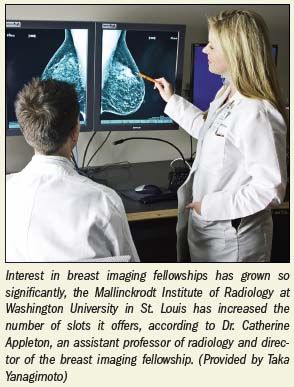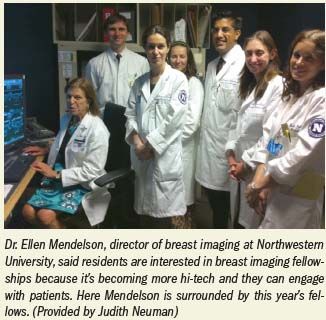Breast imaging fellowships see a jump in applicants
With all the doom and gloom surrounding mammography-lower reimbursement, high threat of malpractice lawsuits-it's easy to assume residents would shy away from the field.
With all the doom and gloom surrounding mammography-lower reimbursement, high threat of malpractice lawsuits-it's easy to assume residents would shy away from the field. But just the opposite is true: residents are flocking to breast imaging fellowships in droves because of the ability to interact with patients and the lifestyle benefits afforded to breast imagers.
A recent survey in the American Journal of Roentgenology found despite concerns about job-related stress, malpractice litigation, and low reimbursement, residents are still choosing the field of mammography (AJR 2010;194:1680-1686).
Of 344 residents surveyed at 26 programs in New York and New Jersey, 7% said they are interested in breast imaging fellowships. The residents believed there was good job availability, a potentially flexible work schedule, and few calls or emergencies.

An informal survey by Diagnostic Imaging found not only are residents interested in breast imaging fellowships, but competition is fierce. It's not uncommon to have 50 to 75 applicants vying for six slots at institutions such as Northwestern University.
GROWTH IN APPLICANT NUMBERS
Over the past five years, breast imaging fellowships have become an increasingly popular choice for residents, said Dr. Catherine Appleton, an assistant professor of radiology and director of the breast imaging fellowship at the Mallinckrodt Institute of Radiology at Washington University in St. Louis.
“In our experience, the number of applicants has steadily increased to far surpass the number of slots we are able to offer,” she said. “Furthermore the average applicant is stellar. Frequently they are former chief residents or have published peer-reviewed articles.”
In addition, since 2003, the number of breast imaging fellowships has grown from two positions per year to five, according to Appleton.
At Stanford University, no fewer than 36 residents apply for one to two fellowship positions per year, according to Joe Hubbard, an administrative associate in Stanford's breast imaging section. For the past few years the university had two fellowship spots and now they have only one.
“While our labor has been cut 50%, the amount of interest in breast imaging has seemingly increased. And knowing that competition is fierce, residents seem to be contacting me earlier in the ballgame,” he said.
In fact, most places are currently in their application cycle for the year 2012.
“I imagine it is very difficult for people to land in a reputable program in less than 10 months' time,” Hubbard said.
You would think residents wouldn't want to go into breast imaging, said Dr. Mary Mahoney, director of breast imaging at the University of Cincinnati Medical Center in Ohio.
“At least in our case, the residents see a group of happy, dedicated physicians who enjoy what they are doing; get to interact with patients, not just PACS workstations; and are respected by [their] colleagues in surgery, oncology, and radiation because of [their] expertise,” she said. “I think our residents are responding to that. Most of our fellows come from our own program, but we certainly get a lot of outside applicants as well.”
One reason for the competitiveness of the fellowships is a perceived need for breast imagers in the job market, according to Dr. Ellen Mendelson, director of breast imaging at Northwestern.
Also, breast imaging has become very high-tech. Mam-mography is now all digital and research and development are going on in all of the modalities, Mendelson said.

“We have become really proficient in imaging-guided procedures, and that is a skill everyone wants and needs-and it's reimbursable,” she said.
“You may see them every year. You have a role to play in their health and in their problems, and they know you,” she said. “It's gratifying to have that kind of patient relationship that, frankly, isn't too taxing with the minutia of life but offers you some opportunity to do physicianly things.”
PATIENT INTERACTION
The patient interaction is one reason Dr. Kate Hallenbeck, a fellow at Indiana University in Indianapolis, chose breast imaging.
“In breast imaging, if you stay in one practice, you frequently see the same patients year after year and can develop patient relationships, a unique thing in radiology,” she said.
Another reason Hallenbeck went into breast imaging is because she enjoys doing minor procedures.
“I love that in the majority of interesting cases for the doctor, we get pathologic correlation fairly quickly. I think that is a huge benefit and really helps you refine your practice through years of experience,” she said. “In many other areas of radiology, you give your best guess, and then may never find out what it is.”
Hallenbeck is also surprised by the number of applicants for breast imaging fellowships. One reason could be precisely because of the highly litigious state of medicine.
“If you want to practice mammography, I think many radiologists believe you might be open to more lawsuits if you are not fellowship-trained in breast imaging,” she said.
Other reasons people may go into breast imaging are that many private practices offer 100% mammography positions, there is no call, there are relatively few emergencies, and the procedures have overall low rates of complication, she said.
A recent graduate from the fellowship program at Mallinckrodt Institute, Dr. Susan Holley said she's surprised she ended up in breast imaging.
“When I started radiology residency, I actually thought the one field I wouldn't choose would be breast imaging,” she said. “At that point in my training, I thought breast imaging seemed, frankly, boring. I thought all you did was look at mammograms with a magnifying glass all day.”
As Holley learned more about the field, her attitude changed, she said.
“Here was a field where you did all sorts of studies: mammograms, ultrasounds, MRIs, as well as procedures: biopsies, needle localizations,” she said.
The clincher for her, though, was contact with patients.
“I think that's the greatest benefit of doing breast imaging: I feel like I'm making a real, tangible difference for patients and their families,” Holley said. “Breast imagers not only detect and diagnose breast cancer, but also talk with the patient about what we've discovered.”
Breast imagers are often the ones who tell a woman she does or does not have breast cancer, which is an emotional and intense experience for everyone involved, she said.
“When you can do it well, you really feel like you've helped someone,” Holley said.
Other draws to breast imaging include learning nuances about breast imaging and blending diagnostic imaging with procedures, she said.
“In addition, I certainly appreciate the fact the breast imaging schedule is more conducive than most physician careers to being a wife/parent. It's important to me to maintain some sort of balance between work and family,” Holley said.
As for why breast imaging is attractive to others, they probably share her reasons, she said: the field is challenging and interesting, includes patient interaction, and allows for a relatively balanced life.
New Collaboration Offers Promise of Automating Prior Authorizations in Radiology with AI
March 26th 2025In addition to a variety of tools to promote radiology workflow efficiencies, the integration of the Gravity AI tools into the PowerServer RIS platform may reduce time-consuming prior authorizations to minutes for completion.
AI-Initiated Recalls After Screening Mammography Demonstrate Higher PPV for Breast Cancer
March 18th 2025While recalls initiated by one of two reviewing radiologists after screening mammography were nearly 10 percent higher than recalls initiated by an AI software, the AI-initiated recalls had an 85 percent higher positive predictive value for breast cancer, according to a new study.